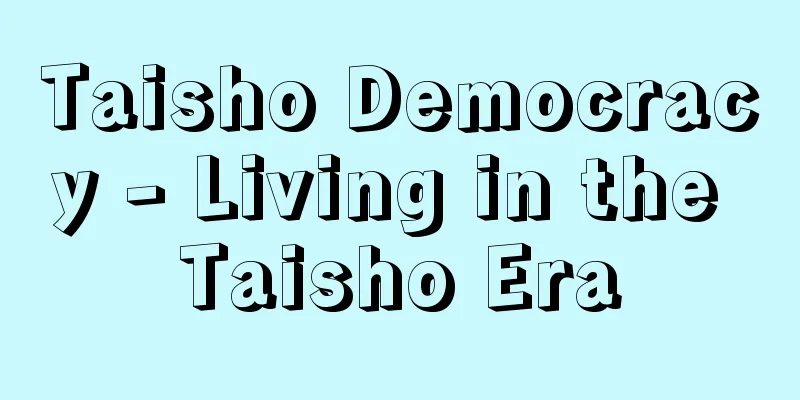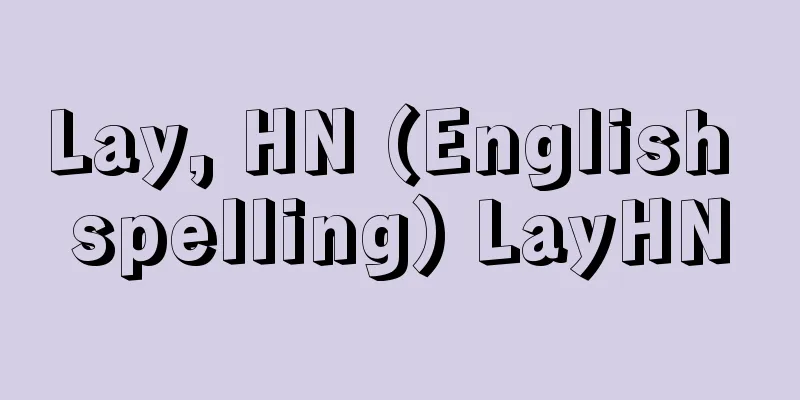Taisho Democracy - Living in the Taisho Era

|
This refers to the democratic and liberal tendencies that were evident in politics, society, and culture from after the Russo-Japanese War until the end of the Taisho period. At its core was the movement for political freedom in opposition to the Meiji Constitution system. [Matsuo Takatsugu] First PeriodFrom the No-Peace Movement during the Russo-Japanese War in 1905 (Meiji 38) to the First Movement to Protect the Constitution in 1912-13 (Taisho 1-2). The No-Peace Movement was a nationwide urban people's movement that included a demand to break down clan-based politics and was guided by the idea of "imperialism abroad, constitutionalism at home," and in this respect it can be considered the starting point of Taisho democracy. The "imperialism abroad" color was weakened through a movement centered on the Chamber of Commerce that took place from 1907 to 1909, which opposed military expansion and demanded the abolition of bad taxes. The First Movement to Protect the Constitution, which was triggered by the issue of adding two divisions, overthrew the Katsura Taro cabinet of the Choshu faction. This was the first example of a people's movement overthrowing a government, and was epoch-making in that it showed that a government without the foundation of political parties could not be maintained even with the authority of the Emperor's imperial edicts. The core of these movements were the non-privileged capitalist class and the urban middle class, which were the product of the development of capitalism after the Russo-Japanese War, and the Toyo Keizai Shinpo, which advocated universal suffrage, disarmament, and the abandonment of Manchuria, was the most radical representative of their political consciousness. Minobe Tatsukichi's theory of the Emperor as an organ of the state denied the Emperor's divinity and asserted the superiority of the House of Representatives as a national organ and the constitutionality of the party cabinet system, thereby giving legitimacy in constitutional interpretation to the demands of the movement to protect the Constitution. During this period, voices calling for civil liberties also rose, and were embodied in the Seito-sha movement by Hiratsuka Raicho, which was the first voice of women's liberation, and the literary movement of Naturalism and the Shirakaba school, which focused on the theme of liberation of the ego from feudal constraints. [Matsuo Takatsugu] Second PeriodFrom the First Movement to Protect the Constitution to the Rice Riots of 1918 (Taisho 7). The postwar boom caused by the start of World War I triggered a reactionary reaction among the non-privileged capitalist class, and the system that had fallen into crisis due to the Movement to Protect the Constitution was saved from this predicament. However, with the growing urban middle class as its base, the democratic movement took root and independent citizen governments with universal suffrage as their central slogan were born all over the country. Led by the Osaka Asahi Shimbun, which boasted the largest circulation, and Chuokoron, which was popular among intellectuals, journalism promoted a democratic climate. This climate was idealized in Yoshino Sakuzo's Minponshugi (people-centered ideology). Yoshino believed that "democracy," meaning sovereignty resides with the people, was not constitutionally permissible, but he established "people-centered ideology," which places the purpose of exercising sovereignty in the realization of the people's welfare and leaves its implementation to the people's decision-making, as the basic principle of constitutional government, and as specific policies based on this, he advocated the adoption of universal suffrage and a party cabinet system domestically, and the abandonment of military aggression policies abroad. Suzuki Bunji applied people-centered ideology to the labor movement, leading to the formation of the Yuaikai, an organization that advocated labor-management cooperation through labor unions, and this organization grew rapidly during the war. [Matsuo Takatsugu] Third PeriodFrom the rice riots to the second constitutional protection movement in 1924 (Taisho 13). Influenced by the rice riots at home and by revolutionary movements in Europe since the Russian Revolution and by the ILO (International Labor Organization), the political consciousness of the working people suddenly increased, and the universal suffrage movement was developed as a nationwide mass movement. At the same time, freedom of speech, assembly, and association was substantially expanded by the power of the people, such as the labor union movement led by the Japanese Labor Federation (the successor to the Yuaikai), the peasant movement led by the Japan Farmers Union, the Buraku Liberation Movement of the Zenkoku Suiheisha, and the women's suffrage movement led by the New Women's Association. The demands of the working people expanded from political freedom to social freedom, and socialism rapidly increased its influence. However, even within socialism, anarcho-syndicalism, which denies political action, was dominant, so advanced workers withdrew from the universal suffrage movement. Demands for peace also grew among the general public; the Siberian Intervention ended in defeat due to a lack of national support, and the disarmament measures implemented at the Washington Conference were welcomed by the public. Due in part to the May 4th and March 1st nationalist movements, the blatant invasion of China was refrained from, and the policy of military assimilation of Korea was revised. Since the formation of the first party cabinet, the Seiyukai cabinet led by Hara Takashi (1918), party forces gained more influence and engaged in political struggles over revisions to the political system to accommodate the development of the democratic movement. The Great Kanto Earthquake and the Tiger's Gate Incident suddenly made the ruling class fear that a revolution was imminent, and as a measure to prevent this and maintain a stable system of rule, a second constitutional protection movement was launched by the three constitutional protection factions - the Kenseikai, the Kakushin Club, and the Seiyukai - which wanted universal suffrage and the establishment of a party cabinet system. These factions won the election by going up against the clan factions, bureaucratic forces, and the Seiyukai party, who wanted to maintain the old system. [Matsuo Takatsugu] ConclusionFrom the Kato Takaaki cabinet, which was established based on the three pro-constitution factions, until the Inukai Tsuyoshi cabinet resigned en masse following the May 15 Incident in 1932 (Showa 7), an era of party politics unfolded in which the two major parties, Seiyukai and Minseito (the successor to the Kenseikai), took turns forming cabinets. Before the Russo-Japanese War, political parties took over the position that had been occupied within the system by the clan-based bureaucratic forces, headed by Yamagata Aritomo. As a result of the passage of the Universal Suffrage Law (1925), the number of voters, which had been less than 1 million before the Russo-Japanese War, exceeded 12 million, accounting for 20% of the mainland population. With the repeal of Article 17 of the Public Order Police Law (1926) and the enactment of the Tenant Conciliation Law (1924) and the Labor Dispute Conciliation Law (1926), the right of workers and farmers to organize and the right to strike were officially recognized, even if only formally, unlimited exploitation of workers was relaxed, and the semi-feudal high rents were reduced by 20-30%. The proletarian forces of workers and farmers advanced into central and local assemblies, and the Women's Civil Rights Bill, which gave women the right to vote in local assemblies, passed the House of Representatives in 1930. With the progress of domestic democratization and under pressure from the new international order led by the United States after World War I, known as the Versailles-Washington system, Shidehara diplomacy, which advocated cooperative diplomacy, became the mainstream of Japanese diplomacy, and Japan's military armaments also fell from 21 divisions during World War I (1915) to 17 divisions by 1926, the level immediately after the Russo-Japanese War. [Matsuo Takatsugu] assignmentHowever, these achievements did not result in a complete overhaul of the Meiji Constitutional system. Not only were constitutional reforms not carried out, but the powers of institutions that threatened parliamentary centralism, such as the Privy Council, the House of Peers, the General Staff, and the Naval General Staff, were not even reduced. On the other hand, the established political parties enacted the Peace Preservation Law (1925), which placed new restrictions on the political freedom of the proletariat, and they also neglected to enact labor protection laws such as the Labor Union Law, or tenant farming laws to guarantee peasants' cultivation rights. As a result, faced with new situations such as the onset of the Great Depression (1930) and the development of the Chinese nationalist movement that threatened Japanese interests on the continent, party politics was unable to take measures to break the deadlock while still responding to the demands of the proletariat, and lost the trust of the people, including the middle class that it had once brought under its control, and after the outbreak of the Manchurian Incident, gave way to the rise of military fascism. However, the popular organizations and ideology that promoted Taisho democracy retained their potential power even during wartime, and became the foundation supporting the postwar democracy that was developed under the demilitarization policy of the occupying forces after the war. [Matsuo Takatsugu] "History of Taisho Democracy" by Nobuo Seizaburo (1954, Nippon Hyoronsha)" ▽ "Study of Taisho Democracy" by Matsuo Takatsune (1966, Aoki Shoten)" ▽ "The Social Formation of Taisho Democracy" by Kanehara Samon (1967, Aoki Shoten)" ▽ "The Undercurrent of Taisho Democracy" by Kano Masanao (1973, NHK Publishing)" ▽ "Study of Post-Russo-Japanese War Political History" by Miyaji Masato (1973, University of Tokyo Press)" ▽ "Theory of Taisho Democracy" by Mitani Taichiro (1974, Chuokoron-Shinsha)" ▽ "Taisho Democracy" by Matsuo Takatsune (1974, Iwanami Shoten) [Reference item] |Source: Shogakukan Encyclopedia Nipponica About Encyclopedia Nipponica Information | Legend |
|
日露戦後から大正末年までの間、政治、社会、文化の各方面に顕著に現れた民主主義的、自由主義的傾向をいう。中心部分を占めるのは明治憲法体制に対抗する政治的自由獲得運動である。 [松尾尊兌] 第一期1905年(明治38)の日露戦争非講和運動より1912~13年(大正1~2)の第一次護憲運動まで。非講和運動は藩閥政治打破の要求を含み、「外には帝国主義、内には立憲主義」の理念に指導された全国的な都市民衆運動であり、この点より大正デモクラシーの起点とすることができる。「外には帝国主義」の色彩は、1907年より09年にかけて展開された軍備拡張反対、悪税廃止を要求する商業会議所中心の運動を通して弱められた。2個師団増設問題を契機とする第一次護憲運動は、長州閥の桂(かつら)太郎内閣を倒したが、これは民衆運動が政府を倒した最初の例であり、政党の基礎をもたぬ政府は、天皇の詔勅の権威をもってしても維持できぬことを示した点で画期的な意味をもつ。これら諸運動の中核となったのは、日露戦争後の資本主義の発展が生み出した非特権資本家層と都市中間層であり、普通選挙、軍備縮小、満州放棄を唱えた『東洋経済新報』は、その政治意識をもっとも先鋭に代表するものであった。また美濃部達吉(みのべたつきち)の天皇機関説は、天皇の神格的絶対性を否定し、衆議院の国家機関における優越性と、政党内閣制の合憲性を主張することにより、護憲運動の要求に、憲法解釈上の合法性を与えた。この時期には市民的自由要求の声も盛り上がり、婦人解放の第一声たる平塚らいてうらの青鞜(せいとう)社、封建的な束縛に対する自我の解放をテーマとする自然主義や白樺(しらかば)派の文学運動に形象化された。 [松尾尊兌] 第二期第一次護憲運動より1918年(大正7)の米騒動まで。第一次世界大戦の開始による大戦景気は、非特権資本家層の反動化をよび、護憲運動により危機に陥った体制は窮地を脱した。しかし増大する都市中間層を基盤に、デモクラシー運動の根は広がり、各地に普選を中心スローガンとする自主的な市民政社が生まれた。最大の発行部数を誇る『大阪朝日新聞』および知識人に人気のある『中央公論』を先頭に、ジャーナリズムはデモクラシー的風潮を鼓吹した。その風潮は、吉野作造(さくぞう)の民本主義に理念化されている。吉野は、主権在民を意味する「民主主義」を憲法上許容できぬとしながらも、主権運用の目的を民衆の利福の実現に置き、かつその運用を民衆の意思決定にゆだねるという「民本主義」を憲政の基本理念として設定し、これに基づく具体的政策として、内には普選と政党内閣制の採用、外には武断的侵略政策の放棄を説いた。民本主義は鈴木文治(ぶんじ)により労働運動に適用され、労働組合を媒介とする労資協調主義を唱える友愛会の結成となり、この組織は大戦中に急速に発展した。 [松尾尊兌] 第三期米騒動より1924年(大正13)の第二次護憲運動まで。内には米騒動、外にはロシア革命以来のヨーロッパにおける革命的諸運動、およびILO(国際労働機関)の影響を受け、勤労民衆の政治的自覚がにわかに高まり、普選運動が全国的大衆運動として展開された。それとともに友愛会の後身日本労働総同盟を先頭とする労働組合運動、日本農民組合を主力とする農民運動、全国水平社の部落解放運動、新婦人協会などによる婦人参政権運動など民衆の実力により、言論・集会・結社の自由が実質的に拡大された。勤労民衆の要求は政治的自由より社会的自由へと拡大され、社会主義が急速に影響力を増大した。しかし社会主義のなかでも、政治行動を否定するアナルコ・サンジカリズムが支配的であったため、先進的労働者は普選運動から離脱した。平和に対する要望も広く民衆の間に強まり、シベリア出兵は国民的支持を欠いて敗北に終わり、ワシントン会議による軍備縮小は民衆に歓迎された。五・四、三・一の両民族運動のためもあって、露骨な中国侵略は手控えられ、朝鮮の武断的同化政策も修正された。最初の政党内閣たる原敬(たかし)政友会内閣の成立(1918)以来、発言権を強化した政党勢力は、デモクラシー運動の発展に適合すべき政治体制の修正をめぐって政争を繰り広げた。関東大震災と虎(とら)の門(もん)事件はにわかに支配層に革命近しの恐れを抱かせ、これを防止し、安定した支配体制を維持するための方策として、普選の採用、政党内閣制の樹立を望む憲政会・革新倶楽部(くらぶ)・政友会の護憲三派による第二次護憲運動がおこり、旧体制の保持を望む藩閥、官僚勢力および政友本党とを向こうに回しての選挙戦に勝利を得た。 [松尾尊兌] 結末護憲三派を基礎として成立した加藤高明(たかあき)内閣以来、1932年(昭和7)の五・一五事件による犬養毅(いぬかいつよし)内閣の総辞職まで、政友・民政(憲政会の後身)の二大政党が交代で内閣を組織する政党政治の時代が展開する。日露戦前、山県有朋(やまがたありとも)を頂点とする藩閥官僚勢力が体制内で占めた地位を政党が奪取したのである。普選法成立(1925)の結果、日露戦前100万人に満たなかった有権者は1200万人を超え、本土人口の20%に達した。治安警察法第17条廃止(1926)および小作調停法(1924)、労働争議調停法(1926)の制定により、労働者・農民の団結権と争議権が形式的にせよ公認され、無制限の労働者搾取は緩和され、半封建的な高額小作料も20~30%減額された。労働者・農民の無産勢力は中央、地方の議会に進出し、婦人に地方議会の選挙権を与える婦人公民権法案も1930年には衆議院を通過した。国内民主化の進行と、ベルサイユ・ワシントン体制と称される第一次世界大戦後の、アメリカ主導による新国際秩序の圧力のもと、協調外交をうたう幣原(しではら)外交が日本外交の主流を占め、軍備も、第一次大戦中(1915)からの21個師団が、1926年には17個師団へと、日露戦争直後の水準に後退した。 [松尾尊兌] 課題これらの成果も明治憲法体制を一新することはできなかった。憲法改正はもとより、枢密院・貴族院・参謀本部・軍令部など、議会中心主義を脅かす諸機構の権限縮小に手をつけるに至らなかった。既成政党勢力は他方では治安維持法(1925)を制定して無産勢力の政治的自由に新たな拘束を加え、また、労働組合法などの労働者保護法や、農民の耕作権を保障する小作法の制定を怠った。このため、世界大恐慌の襲来(1930)、大陸における日本権益を脅かす中国民族運動の発展という新事態に直面し、政党政治は無産勢力の要望を入れつつ局面を打開する方策をとりえず、一度は傘下に収めた中間層を含む民衆の信頼を喪失し、満州事変勃発(ぼっぱつ)以後軍部ファシズムの興隆に道を譲ることになった。しかし、大正デモクラシーを推進した民衆組織と思想は戦時下といえども潜在勢力を保持し、戦後、占領軍の非軍事化政策のもとに展開された戦後民主主義を支える基盤となった。 [松尾尊兌] 『信夫清三郎著『大正デモクラシー史』(1954・日本評論社)』▽『松尾尊兌著『大正デモクラシーの研究』(1966・青木書店)』▽『金原左門著『大正デモクラシーの社会的形成』(1967・青木書店)』▽『鹿野政直著『大正デモクラシーの底流』(1973・日本放送出版協会)』▽『宮地正人著『日露戦後政治史の研究』(1973・東京大学出版会)』▽『三谷太一郎著『大正デモクラシー論』(1974・中央公論社)』▽『松尾尊兌著『大正デモクラシー』(1974・岩波書店)』 [参照項目] |出典 小学館 日本大百科全書(ニッポニカ)日本大百科全書(ニッポニカ)について 情報 | 凡例 |
>>: Grand Minister of State - Dajo Daijin
Recommend
Sharebon - Sharebon
A type of novel form that became popular after th...
William II (Governor of the Netherlands) - William
…Governor of the Netherlands. The youngest son of...
Autogiro (English spelling)
A type of rotorcraft that generates lift using rot...
University of Tartu - Tartu Ülikool
A prestigious university in Tartu, Republic of Est...
Simon de Montfort
1208‐65 English nobleman. Son of the French noblem...
Levirate
The custom of a brother marrying in place of a dec...
capers
Capparis spinosa is a shrub of the Capparaceae fam...
Vāyu - Bāyu (English spelling)
An ancient Indian wind god. One of the nature dei...
The Duke of Hata - The Duke of Hata
A legendary figure from the Hata clan, a clan of i...
Physicalism
…However, dissatisfied with this position, the ba...
Industrial Bank - Kangyōginko
= Japan Industrial Bank (Nippon Kangyō Ginkō) *Tok...
Business - Go
A translation of the Sanskrit word karman. It was...
Acmaeidae
…A shell shaped like an upturned cap (illustratio...
percussion-lock
...In the above types, the fire from the ignition...
Semipermeable membrane
A membrane that allows only some of the component...









